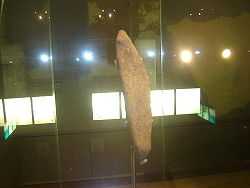Zenata
Zenata (Berber: Iznaten) are a major old Berber ethnic group of North Africa. They were an umbrella-group encompassing probably hundreds of large linguistically or genealogically related Berber tribes in the north, center and east of Berber North Africa (excluding the Nile valley of Egypt). Zenata Berbers were the founders of several Berber empires, kingdoms and princedoms in North Africa.
According to Ibn Khaldun, a North African historian of the 14th century, there were Zenata tribes dispatched in all North Africa (current Morocco, Libya, Tunisia, Algeria)
According to Ibn Khaldoun, the Zenata are one of the main divisions of the medieval Berbers, along with Senhaja and Masmuda. He added that these tribes, were both nomadic and sedentary as well as builders of cities and were concentrated in Middle Maghreb (roughly the current northern Algeria and its surroundings). It is why he called "Middle Maghreb" home of Zenata.
There have been some medieval hypotheses about the foreign origine of this Berber group but were already rejected by Ibn Khaldun in the 14th-century. Furthermore they are not accepted by the modern historians such as Emile Felix Gautier or Gabriel Camps.
Zenatas could come from Numidians and Gaetulia (Berber people of North Africa during classical antiquity)[1]
According to some hypotheses, the Berber tribes of the Garamantes could be also probably Zenati.[2]
According to the very discussed hypothesis of Ibn Khaldun, Madghacen was the Patriarch of Zenata.[3]
The oldest mausoleum (between 12 B.C. and 3 B.C) in current Algeria is Madghacen mausoleum (Madghis town near Batna). Madghacen was probably a Zenata king of Numidia.[4]
The Zenata were known for their horseriding skill. The Spanish word for "horserider", jinete,[5] is derived from their name.
Language
Their varieties of Berber, collectively termed Zenati, are spread over a wide area; for this reason, several languages are termed "Zenati" or in some cases are spoken by people who call themselves Zenata.
Currently, the largest Zenata Berber language variety is Rif Berber (locally called: Tmaziɣt), spoken in the Rif region of northern Morocco. The second largest Zenata Berber language variety is the Chaoui Berber language spoken by the Shawi people in northeastern Algeria.
Other Zenata Berber groups include Ayt Iznasen near Berkane in northern Morocco, Mzab people in Algeria, Figuig city in eastern Morocco, Tamezret and Sened people in Tunisia, Zuwara city in Libya, Ouargla and Taznatit-speaking people in Algeria, and many more.
The Zenata are also recalled in several placenames across the Maghreb, notably Oued Zenati in Algeria.
History
The Egyptians named the Ancient Libyans to the West of Egypt Libu, Zenata tribes lived to the west of the Ancient Libyans.
They may be related to the Cinithii mentioned by Tacitus in the Annals who inhabited the lands to the South of Tunisia saying they were not just a tribe but very numerous peoples.
In the 8th century most Berbers and Zenata were Kharijites and took part in the Maysara revolt against Umayyad rule. The last Kharijite rebellion was in the 10th century under Abu Yazid, and was defeated by the Fatimids.
During the 10th century some Zenata from Ifriqiya were predominantly allied with the Caliphate of Cordoba, which fought for control of a part of current Morocco with the Fatimids. In the process the Zenata were pushed out of Morocco by the Sanhaja tribe, allies of the Fatimids.
In the 13th century the Zenata regained political importance with the Abdalwadids in present-day western Algeria and eastern-Morocco
From the 13th to 16th century, in Morocco, the Zenata-based dynasties of the Marinids and the Wattasids ruled the country.[6]
See also
References
- ↑ Recueil des notices et mémoires de la Société archélologique de la province de Constantine. 1874.
- ↑ http://www.mondeberbere.com/azayku/txt/genealogie.htm
- ↑ Ibn khaldun, History of Berbers
- ↑ Gautier, Émile Félix (1952). Le passé de l'Afrique du Nord: Les siècles obscurs.
- ↑ jinete in the Diccionario de la Real Academia Española.
- ↑ Nelson, Harold D. (1985). Morocco, a country study. Washington, D.C.: The American University. pp. 23–25.
External readings
- Rachid Bellil, Université d'Alger. "Les Zénètes du Gourara d’hier à aujourd’hui (Sahara Zenatas)". Retrieved December 9, 2012.
- Norman Roth. Jews, Visigoths, and Muslims in Medieval Spain: Cooperation and Conflict. Retrieved December 9, 2012.
